All Sound is Music
Laurie Anderson Interview
January 22, 2020 | by Richard Scheinin
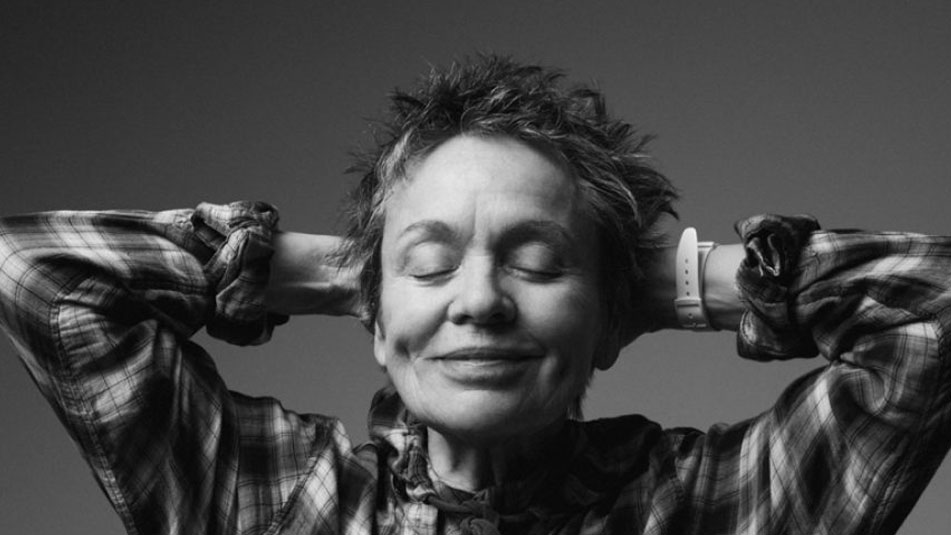
Laurie Anderson
For Laurie Anderson, all sound is music.
At the same time, she says, music is a lot like painting; a brushstroke is like a note, pointing to what comes next. With Anderson you never know quite what to expect. She composes. She paints. She sculpts. She directs films. She writes and tells stories. She plays the viola and sings, running her voice through strange distorting devices. She is an avant-gardist who became a pop star. She is a performance artist who designs software and, lately, virtual reality environments, always searching for what she calls “disembodiment.” It’s her goal as an artist: “To get lost and to get free. That’s a big thing for me, is just to cut myself loose from things,” she says. “But it’s never easy to be free. It’s a very hard thing to do. So I’m very conscious of how that is working and sometimes the traps that you make for yourself are so clever, and you can’t even get out of ‘em. And you think it’s freedom and it’s just another structure that’s holding you back.”
Anderson, 72, explains all this over the phone, while working on a 14-by-11-foot painting at her studio in the Brooklyn Navy Yard. As she describes her creative process – “there’s a certain amount of intuition and a certain amount of analysis that I have to use to get to the point of being free” – one can hear the sounds of brushstrokes, the layering on of paint, and then the sounds of a scraper, as she removes paint from canvas. She works from the gut, then steps back to assess, she says. Then she takes the next step.
Working from a different kind of blank canvas – a carte blanche invitation to present whatever she likes – Anderson is leading four shows at SFJAZZ (Jan. 23-26), where she is a resident artistic director this season. She has engaged three musical guests who “are almost opposites,” she notes, “and that’s the point.” There’s Mike Patton, best known as lead singer – with a six-octave range -- of Faith No More, the alternative metal band. There’s Christian McBride, the super virtuoso jazz bassist, whose collaborators have ranged from Ray Brown to John Zorn. And there’s Rubin Kodheli, a classical cellist who has played with Snoop Dogg and Joan Jett. All three guests are “incredible improvisers,” says Anderson, who is trying to stir up as much trouble as possible by inviting such a varied crew to perform with her. Each night should be distinctive: She and the other musicians will simply step into the void, assess what’s happening – and, she hopes, cut loose and “get free.”
“But I find things almost never come out the way I think they’re going to,” she admits. Sometimes the search for freedom collapses, and she “comes back to a vocabulary with which I’m comfortable. A blank canvas is never that blank; you may bring a lot of things that you think are brand new, but they never are. I’ve done a lot of things that I thought, `Oh! This is a brand new idea. Wow.” And then somebody says, `Um, you know, that’s actually a lot like what you’ve done in the’ blah blah blah. The truth is, I probably haven’t done anything new in quite a while.”
With Anderson – who once gave a street-corner viola recital while wearing skates embedded in melting blocks of ice – such a statement should be taken with a grain of salt.
We spoke to her about her four upcoming shows in San Francisco – how they came about, and what she hopes will happen with each.
Laurie Anderson: Duet with Rubin Kodheli (Jan. 24)
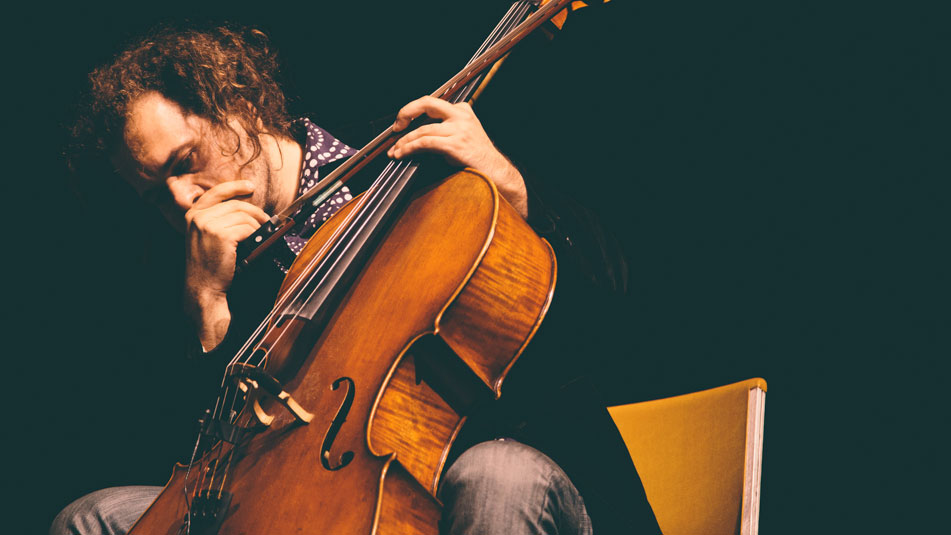
Rubin Kodheli
She recalls the first time she met the cellist: “It was in New York, and I met Rubin, weirdly, at the Rubin Museum where we were doing an improv for a piece that was based on The Tibetan Book of the Dead. I didn’t even know who he was. It was me, Rubin, Tenzin Choegyal, Jesse Paris Smith and Shahzad Ismaily, and we did no rehearsal for this whatsoever – absolutely nothing. And it was very interesting just to read this text, which is a very esoteric text, and I’ll probably do some of that in San Francisco. And that evening, at the Rubin Museum, I kept hearing these really beautiful sounds, and every time I turned around to see what it was, it was Rubin. I thought, `Wait a minute! This guy is a one-man show.’ Sometimes it was harmonics. Sometimes it was just a beautiful line, and when it was over, I said, `Who are you?’”
They became a team: “We just make each other laugh; it’s so much fun to play, and I can’t think of anyone else where that happens,” she says, pausing to think about it. “Well, I had that with Lou,” she adds, meaning the late Lou Reed, to whom she was married. “We had that experience, where we would always laugh. It was like, `What? You played that? You got to be kidding!’”
At moments like this, Anderson, who grew up in a small town in Illinois, still sounds like a bright-eyed kid – even though she’s been a doyen of the downtown New York avant- garde for half a century. She goes on: “And that’s what it’s like with Rubin. I think he’s never played the same thing twice. Sometimes you’re playing with people, even great improvisers, and they get into these riffs and sort of repeat these ideas -- and I do, as well. Most musicians do. He doesn’t do that. He’s an endless font of musical ideas. My jaw’s completely dropped for half of the set: `What did you just play?’ It pushes me to do something more than my usual repertoire.”
At SFJAZZ, the duo will explore “a lot of text,” though she hasn’t decided exactly what, wanting to “keep it loose, more improvisational.” She may include portions of her show The Art of Falling: “It’s a bunch of stories, where he’s doing sort of very beautiful, trance-like vibey things. And he’s probably the person I like to play with most, in terms of my doing vocals. Because he’s so intuitive and he really lets the language lead, and a lot of people play too much. He doesn’t play too much, and that’s a skill.”
On YouTube, you can watch Kodheli playing Chopin, boogie-woogie, or some Hendrix-inspired electric cello. In San Francisco, Anderson says, the cellist will “be plugged in, but he won’t use any processing. He doesn’t need electronics like I do.” You can expect her to bring along her usual arsenal of iPads, laptops and foot pedals, along with her electric viola. Paired with Kodheli, she anticipates creating a conversation-like musical flow that’s filled with unexpected sounds: “Because when Rubin and I play, it’s like we turn into some kind of weird hybrid instrument. It’s like the electric viola and the cello make a third instrument that’s almost indefinable. It’s hard to describe what it is, exactly.
"It’s just a stupid amount of fun to play with that man. It’s just ridiculous.”
LAURIE ANDERSON: TRIO WITH CHRISTIAN MCBRIDE AND RUBIN KODhELI (JAN. 23)
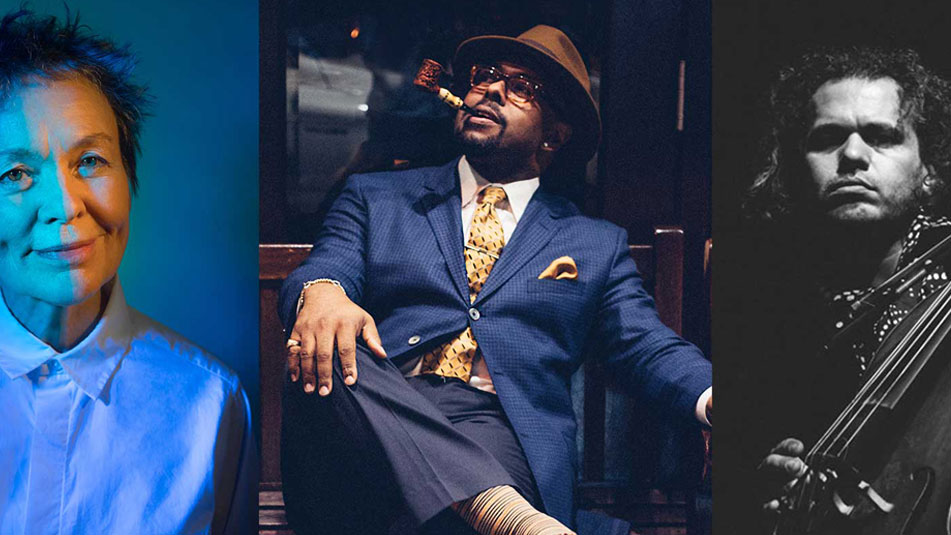
Laurie Anderson, Christian McBride, Rubin Kodheli
Anderson made her reputation in the late ‘60s and 1970s as a performance artist, scoring an early “symphony” (sort of) for a choir of automobile horns. McBride broke into the straight-ahead jazz scene in the late 1980s and early ‘90s; a kid who could play anything, he was hired by legends like Freddie Hubbard and J.J. Johnson. Kodheli grew up in Albania and, in the 1990s, won a scholarship to Juilliard, studying with the revered cellist Fred Sherry and aiming to master the standard classical repertoire.
“We’re all from different worlds,” says Anderson, “and that’s what makes this trio something wild. It’s really like nothing that I’ve ever heard before. Who would imagine that the three of us could even co-exist on the same stage, right?”
She met McBride through a mutual friend, Gina Gershon, the actress and singer. “And I was just completely knocked out, hearing Christian. I was so blown away by what he was doing. And I remember telling an assistant, `Well, the person I feel like playing with would never play with me.’ And when I told her who, she said, `Oh, I can set that up.’ And she made the connection and Christian said, `OK, I’ll do it.’
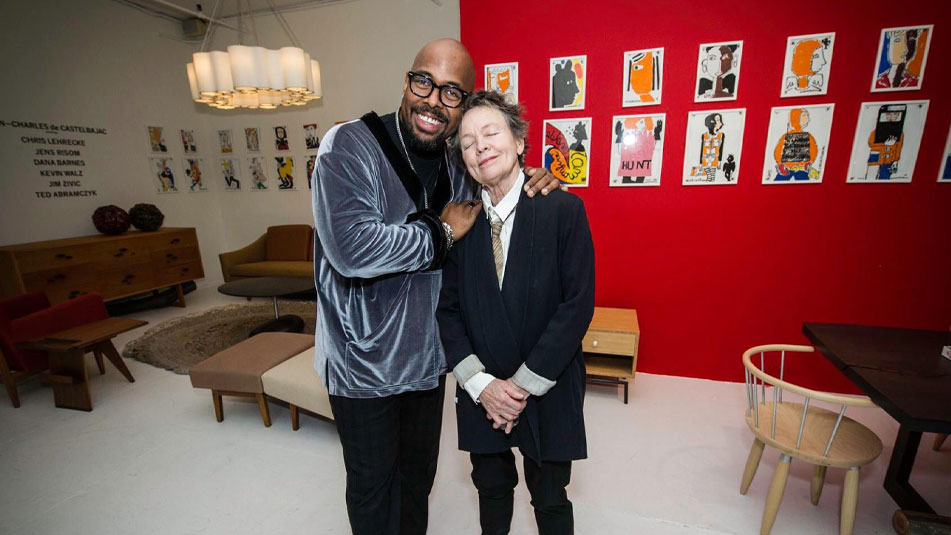
Christian McBride and Laurie Anderson
“So we played Town Hall two or three years ago and then we did the Newport Jazz Festival, and that one in particular was really exciting to me because there are so many jazz cats who, when they see me come out with the violin – I could just feel it. It was like, `Oh no, here she is with her electric violin, Ms. Avant-garde.’ I got that vibe right away. But in the first five minutes, I realized they were all listening. And at the end, a bunch of those guys came up to me and said, `Wait a second, do you know Ornette?’ I said, `Yeah, I played with Ornette.’ And they were like, “Oh! That’s why you’re playing that stuff.” I loved Ornette Coleman. You know, people get into their own scenes so much that they don’t realize what we hold in common.”
Anderson spent her early career in New York with “a very mixed group of people: dancers and sculptors, painters and musicians like Philip Glass. It was a scene where we listened to each other and helped each other find our way.” Perhaps the trio with McBride and Kodheli is like that: “It’s about building something, putting on layers – like painting this canvas I’m working on. I just finished a 14-by-11 foot layer of color, and it’s not what I expected, and it’s giving me all these ideas for the next layer. And it’s the same with music or with a group of musicians; you put down one note or one track and it changes everything that follows.”
LAURIE ANDERSON: “QUANJING JIEYAO PIAN,” WITH MIKE PATTON (JAN. 25)
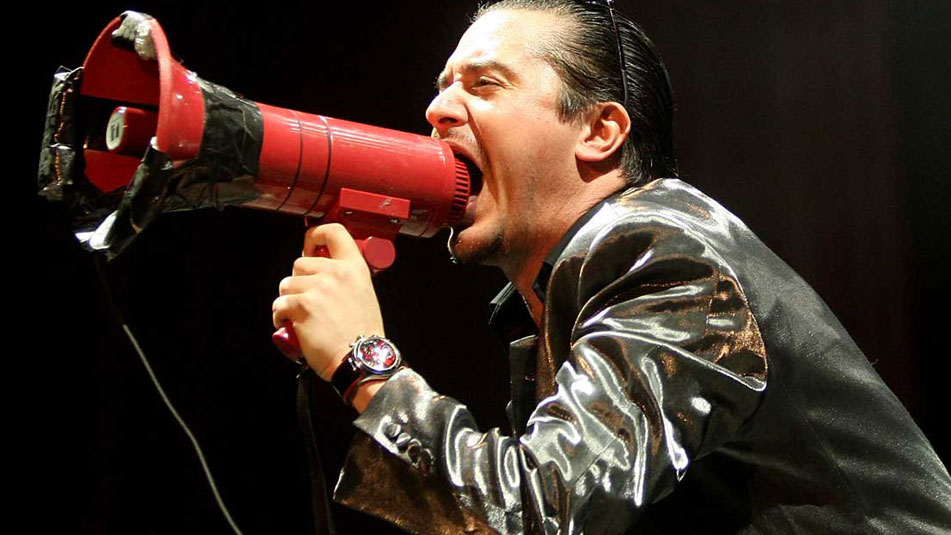
Mike Patton
Anderson’s third program takes its title from a 16th century text on military tactics, written by a general from the Ming Dynasty. Specifically, it’s about unarmed combat, and about nimbleness, a quality that appeals to Anderson. As originally advertised, the program would utilize the text – composed in verse -- as a kind of springboard for improvisations by Anderson and guest Mike Patton. But as the show approaches, she seems unsure: “I’ve decided not to define things so much. I want to leave it more open. We’ll see.”
Over a 35-year career, Patton’s voice has been out front with bands like Faith No More, Mr. Bungle, Tomahawk, Dead Cross, Fantomas, and Peeping Tom. His voice is massive: rasping, yowling, howling, and practically atomizing – loaded with harmonics and multiphonics, like heavy metal Coltrane. But he can also be disconcertingly romantic, almost operatic while singing a ballad by Burt Bacharach. Certainly, he’s nimble: “I’ve always loved Mike Patton,” Anderson says. “I haven’t known him, but I’ve known his music, and I’ve always wanted to work with him, so here we are. I’m getting together some really unusual texts for him to work with” – again, she doesn’t say which – “and we’ll see what happens.”
She met him in September 2018 at The Chapel in San Francisco, where John Zorn was celebrating his 65th birthday with a series of performances. One night, while Zorn played with Anderson and composer Terry Riley, Patton sat in: “It was loud and it was intense. It was not that melodic,” she says, with a chuckle. “But there were moments of beautiful notes in there, too. It’s almost impossible to summarize what it was like, because it changed from second to second.
“I am fascinated with people who go really over the top in their vocalizing -- and he really goes for it,” Anderson says of Patton. “ Playing with Zorn, I’ve been trying to go to that place more often. And there’ve been times that I’ve played with Yoko Ono – she can do that, and it’s just a thrill. It’s amazing to open yourself up like that and just go out. That’s what Mike did at The Chapel. That’s what he does.”
Laurie Anderson: Solo (Jan. 26)
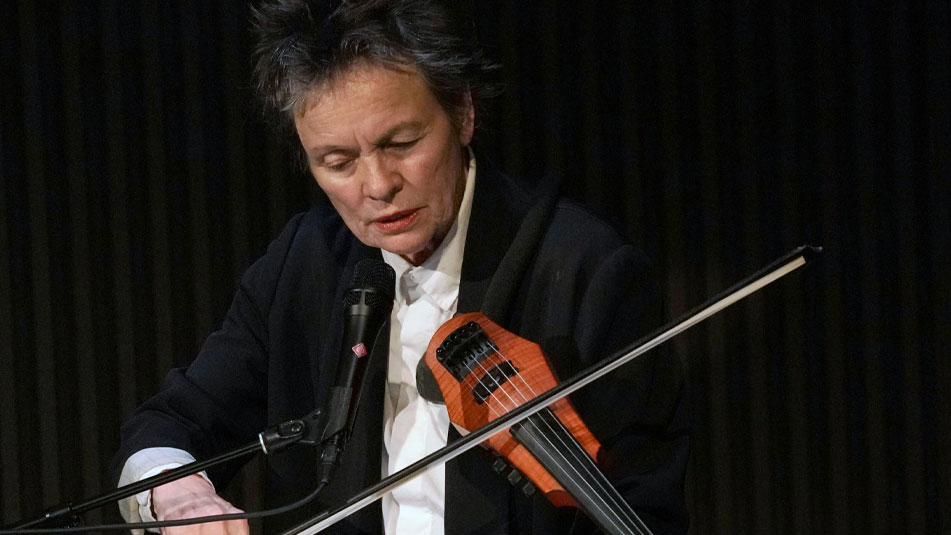
Laurie Anderson
Of all her programs, this solo show “is the one that’s most up in the air,” Anderson says. She will have spent the first three nights of her residency “getting used to the space and feeling comfortable there, and knowing who the audience is, and becoming familiar with the sound system. That’s one of the things that’s really great about being able to stay in one place for a while; by the end, you don’t need to adjust so much. And that’s why I put the solo show last. I’m hoping that it builds on the first three -- that there’ll be a snowball effect.”
She offers a handful of details: “I’m going to make it more of a reading – something text-based, with vocals and processing. And I’m not going to have any visual things this time; I don’t really need them. I’m just trying to pare things down lately. I’m writing stuff that is really risky for me, and I’m just going to try it out. We’ll see how brave I get. It’s from a book that I’m working on.”
What’s it about?
“Let’s just say it’s more personal than what I’m used to doing. It’s taken me a long time to trust myself this way and just go.”
She laughs.
“We’ll see if I have the nerve.”
A staff writer at SFJAZZ, Richard Scheinin is a lifelong journalist. He was the San Jose Mercury News' classical music and jazz critic for more than a decade and has profiled scores of public figures, from Ike Turner to Tony La Russa and the Dalai Lama.
